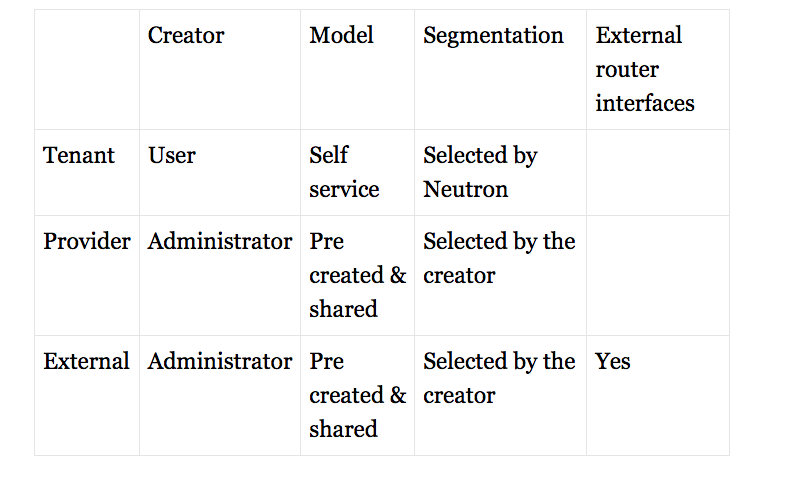To this day I see confusion surrounding the terms tenant, provider and external networks. No doubt countless words have been spent trying to tease apart these concepts, so I thought that it’d be a good use of my time to write 470 more.
At a glance
A closer look
Tenant networks are created by users and Neutron is configured to automatically select a network segmentation type like VXLAN or VLAN. The user cannot select the segmentation type.
Provider networks are created by administrators, that can set one or more of the following attributes:
- Segmentation type (flat, VLAN, Geneve, VXLAN, GRE)
- Segmentation ID (VLAN ID, tunnel ID)
- Physical network tag
Any attributes not specified will be filled in by Neutron.
OpenStack Neutron supports self-service networking – the notion that a user in a project can articulate their own networking topology, completely isolated from other projects in the same cloud, via the support of overlapping IPs and other technologies. A user can create their own network and subnets without the need to open a support ticket or the involvement of an administrator. The user creates a Neutron router, connects it to the internal and external networks (defined below) and off they go. Using the built-in ML2/OVS solution, this implies using the L3 agent, tunnel networks, floating IPs and liberal use of NAT techniques.
Provider networks (read: pre-created networks) is an entirely different networking architecture for your cloud. You’d forgo the L3 agent, tunneling, floating IPs and NAT. Instead, the administrator creates one or more provider networks, typically using VLANs, shares them with users of the cloud, and disables the ability of users to create networks, routers and floating IPs. When a new user signs up for the cloud, the pre-created networks are already there for them to use. In this model, the provider networks are typically routable – They are advertised to the public internet via physical routers via BGP. Therefor, provider networks are often said to be mapped to pre-existing data center networks, both in terms of VLAN IDs and subnet properties.
External networks are a subset of provider networks with an extra flag enabled (aptly named ‘external’). The ‘external’ attribute of a network signals that virtual routers can connect their external facing interface to the network. When you use the UI to give your router external connectivity, only external networks will show up on the list.
To summarize, I think that the confusion is due to a naming issue. Had the network types been called: self-service networks, data center networks and external networks, this blog post would not have been necessary and the world would have been even more exquisite.
About the author
Assaf Muller manages the OpenStack network engineering team at Red Hat. This post first appeared on his blog.
Superuser is always looking for tutorials and opinion pieces about open infrastructure, get in touch at editorATopenstack.org

)








